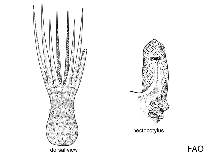Galeoctopus lateralis Norman, Boucher & Hochberg, 2004
Sharkclub octopus| Native range | All suitable habitat | Point map | Year 2050 |

|
| This map was computer-generated and has not yet been reviewed. |
| Galeoctopus lateralis AquaMaps Data sources: GBIF OBIS |
Классификация / Names народные названия | синонимы | CoL | ITIS | WoRMS
Cephalopoda | Octopoda | Octopodidae
Environment: milieu / climate zone / пределы глубины / distribution range экология
пелагический; пределы глубины 188 - 430 m (ссылка 1826). Tropical
Distribution страны | регионы FAO | Ecosystems | места находок | интродукции
Central Pacific.
Length at first maturity / Size / Weight / Возраст
половая зрелость: Lm ? range ? - ? cm Max length : 16.5 cm TL самец/пол неопределен; (ссылка 96968); наибольший вес (опубликованные данные): 18.00 g (ссылка 1826)
Life cycle and mating behavior половая зрелость | размножение | нерест | Eggs | Fecundity | Larvae
Основная ссылка
ссылки | координатор | соавторы
Norman, M.D., R. Boucher and F.G. Hochberg 2004 The sharkclub octopus, Galeoctopus lateralis, a new genus and species of deep-water octopus from the western Pacific Ocean (Cephalopoda: Octopodidae). Journal of Molluscan Studies 70:247-256. (ссылка 1826)
Статус Красного Списка МСОП
(ссылка 130435: Version 2025-1)
Статус СИТЕС (ссылка 108899)
CMS (ссылка 116361)
Угроза для людей
Использование человеком
| FishSource |
инструменты
дополнительная информация
Max. ages / sizes
Length-weight rel.
Length-length rel.
Размерный состав
Mass conversion
численность
ресурсы в Интернет
BHL | BOLD Systems | CISTI | DiscoverLife | FAO(Publication : search) | Fishipedia | GenBank (Геном, Нуклеотид) | GloBI | Gomexsi | Google Books | Google Scholar | Google | PubMed | Tree of Life | Wikipedia (Вперёд, поиск) | Zoological Record



